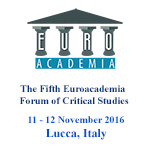Euroacademia Conferences
 Europe Inside-Out: Europe and Europeanness Exposed to Plural Observers (9th Edition) April 24 - 25, 2020
Europe Inside-Out: Europe and Europeanness Exposed to Plural Observers (9th Edition) April 24 - 25, 2020 Identities and Identifications: Politicized Uses of Collective Identities (9th Edition) June 12 - 13, 2020
Identities and Identifications: Politicized Uses of Collective Identities (9th Edition) June 12 - 13, 2020 8th Forum of Critical Studies: Asking Big Questions Again January 24 - 25, 2020
8th Forum of Critical Studies: Asking Big Questions Again January 24 - 25, 2020 Re-Inventing Eastern Europe (7th Edition) December 13 - 14, 2019
Re-Inventing Eastern Europe (7th Edition) December 13 - 14, 2019 The European Union and the Politicization of Europe (8th Edition) October 25 - 26, 2019
The European Union and the Politicization of Europe (8th Edition) October 25 - 26, 2019 Identities and Identifications: Politicized Uses of Collective Identities (8th Edition) June 28 - 29, 2019
Identities and Identifications: Politicized Uses of Collective Identities (8th Edition) June 28 - 29, 2019 The European Union and the Politicization of Europe (7th Edition) January 25 - 26, 2019
The European Union and the Politicization of Europe (7th Edition) January 25 - 26, 2019 7th Forum of Critical Studies: Asking Big Questions Again November 23 - 24, 2018
7th Forum of Critical Studies: Asking Big Questions Again November 23 - 24, 2018 Europe Inside-Out: Europe and Europeanness Exposed to Plural Observers (8th Edition) September 28 - 30, 2018
Europe Inside-Out: Europe and Europeanness Exposed to Plural Observers (8th Edition) September 28 - 30, 2018 Identities and Identifications: Politicized Uses of Collective Identities (7th Edition) June 14 - 15, 2018
Identities and Identifications: Politicized Uses of Collective Identities (7th Edition) June 14 - 15, 2018
The Culture-Led Construction of the Urban Image: New Public Libraries in the Netherlands
-
-

-
Presentation speakers
- Olindo Caso, Department of Architecture / Faculty of Architecture and the Built Environment, Delft University of Technology
- Download presentation
Abstract:
This paper deals with the role of culture and in particular of the cultural institution of the public library in the (re)construction of the urban identity in a context of an evolving postmodern cultural economy. Paralleling a cultural-turn in post-industrial socio-economics, the production of ‘signs’ of aesthetic contents supports logics of urban branding able to create desire and induce attractiveness through social and spatial identity. Accordingly culture becomes a local asset. A new generation of public libraries is increasingly becoming part of this narrative in a more efficacious way than other cultural institutes like theatres or museums. This rising urban relevance of public libraries is paralleled and supported by their transformation from introvert repositories of collections into hybrid, multifaceted institutions targeted upon the aspirations of a community. Libraries todays are environments of synchronic production and consumption of culture by ‘prosumers’; a collective access-door to digital marketplaces and platforms. This evolution is evident in the Netherlands too, where many contemporary urban projects involve a new public library as the cultural anchor for refreshing the urban image. These new libraries contribute in different ways to the construction / transformation of the plural identities of the urban setting: as field of negotiations among cultures and agencies; as an architectural image that embodies the re-envisioning of local urbanity; as a creative, value-making workshop forging the image of the community. It is thus interesting to read the parallelisms among the urban image of the city, the branding topics, and the type of public library: an anatomy of its architecture, programming and strategic management. Drawing upon available research on city-library relationships this paper will discuss recent Dutch experiences emphasizing the connections between different local urban images and identities, and their strategic construction between design and community participation.
-
Related Presentations

(Im)Possible Subjects: The Appearance and Disappearance of Greek Woman Writer Dora Rosetti Performing Forbidden Lesbian Desire and Identity in “Her Lover” and in “My Friend Mrs Dora Rosetti”
- Elisavet Pakis













